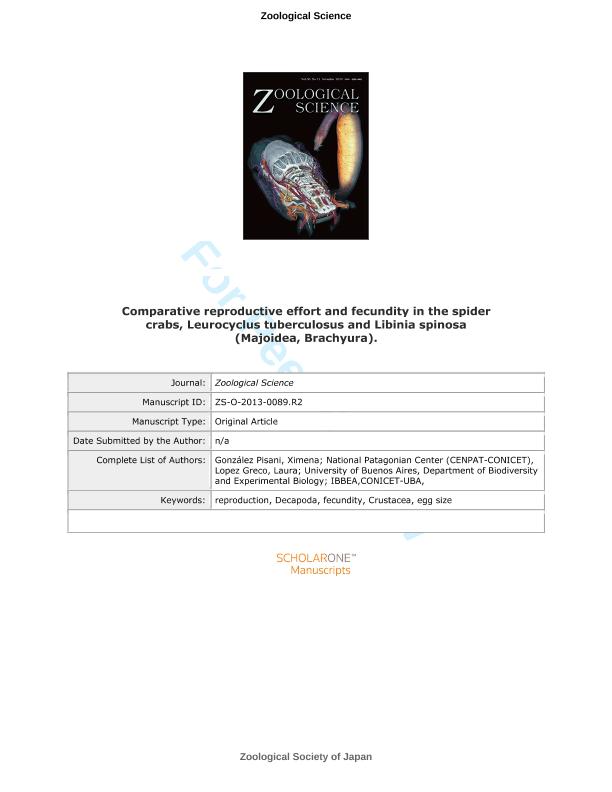Mostrar el registro sencillo del ítem
dc.contributor.author
Gonzalez Pisani, Ximena

dc.contributor.author
Lopez, Laura Susana

dc.date.available
2019-07-12T20:01:22Z
dc.date.issued
2014-04
dc.identifier.citation
Gonzalez Pisani, Ximena; Lopez, Laura Susana; Comparative reproductive effort and fecundity in the spider crabs, leurocyclus tuberculosus and libinia spinosa (Majoidea, Brachyura); Zoological Society of Japan; Zoological Science; 31; 4; 4-2014; 244-250
dc.identifier.issn
0289-0003
dc.identifier.uri
http://hdl.handle.net/11336/79510
dc.description.abstract
A comparative analysis of reproductive effort, fecundity, and egg weight was conducted in two species of spider crabs, Leurocyclus tuberculosus and Libinia spinosa, during one-year period. Ovigerous females were collected from Patagonia-Argentina (42°56′S, 64°21′W) and were measured (CW = carapace width). Each egg brood was weighed, dried and the number of eggs (F = fecundity) counted. Scatterplots of relative fecundity (RF = F/CW) were submitted to regression analyses. Mean F and RF was calculated for each season to assess seasonal variation of reproductive intensity. Mean F was 35,000 eggs in L. tuberculosus and 30,000 eggs in L. spinosa, with these values being intermediate in comparison with other Majoidea. The RF was approximately 18% higher in L. tuberculosus that presented an average dry weight egg 45% less than L. spinosa. Although in both species F showed a positive correlation with CW, less than the 20% of the variation in the number of eggs could be explained by female's size, suggesting there are other factors that influence F. The proportion of body energy devoted to reproduction (reproductive effort), exhibited significant differences between species. In Leurocyclus tuberculosus reproductive activity is significantly different along the 12-month suggesting that the conditions for 'optimal' egg production change throughout the year. In Libinia spinosa mean fecundity did not reveal significant differences over seasons. These results are central in studies of life-history theory and in the development of lifehistory models, as it is directly related to energy allocation and partitioning.
dc.format
application/pdf
dc.language.iso
eng
dc.publisher
Zoological Society of Japan

dc.rights
info:eu-repo/semantics/openAccess
dc.rights.uri
https://creativecommons.org/licenses/by-nc-sa/2.5/ar/
dc.subject
Fecundity
dc.subject
Leurocyclus
dc.subject
Libinia
dc.subject
Majoidea
dc.subject
Reproductive Effort
dc.subject.classification
Biología del Desarrollo

dc.subject.classification
Ciencias Biológicas

dc.subject.classification
CIENCIAS NATURALES Y EXACTAS

dc.title
Comparative reproductive effort and fecundity in the spider crabs, leurocyclus tuberculosus and libinia spinosa (Majoidea, Brachyura)
dc.type
info:eu-repo/semantics/article
dc.type
info:ar-repo/semantics/artículo
dc.type
info:eu-repo/semantics/publishedVersion
dc.date.updated
2019-06-03T19:34:36Z
dc.journal.volume
31
dc.journal.number
4
dc.journal.pagination
244-250
dc.journal.pais
Japón

dc.journal.ciudad
Tokio
dc.description.fil
Fil: Gonzalez Pisani, Ximena. Consejo Nacional de Investigaciones Científicas y Técnicas. Centro Nacional Patagónico; Argentina
dc.description.fil
Fil: Lopez, Laura Susana. Consejo Nacional de Investigaciones Científicas y Técnicas. Oficina de Coordinación Administrativa Ciudad Universitaria. Instituto de Biodiversidad y Biología Experimental y Aplicada. Universidad de Buenos Aires. Facultad de Ciencias Exactas y Naturales. Instituto de Biodiversidad y Biología Experimental y Aplicada; Argentina
dc.journal.title
Zoological Science

dc.relation.alternativeid
info:eu-repo/semantics/altIdentifier/doi/https://doi.org/10.2108/zs130089
dc.relation.alternativeid
info:eu-repo/semantics/altIdentifier/url/https://bioone.org/journals/zoological-science/volume-31/issue-4/zs130089/Comparative-Reproductive-Effort-and-Fecundity-in-the-Spider-Crabs-Leurocyclus/10.2108/zs130089.short
Archivos asociados
